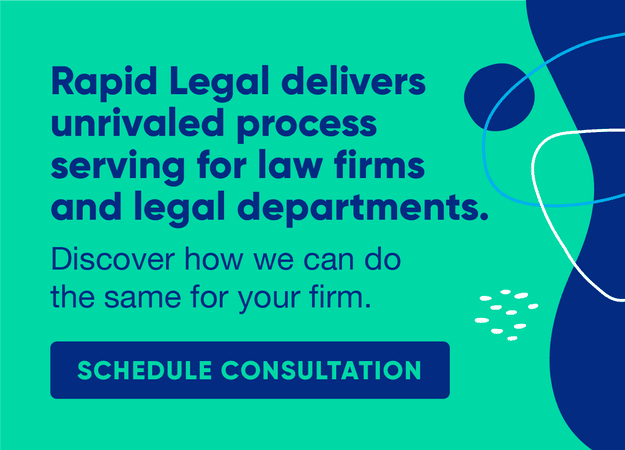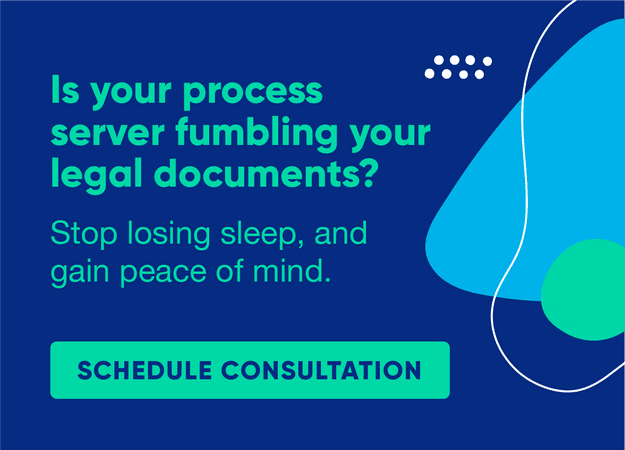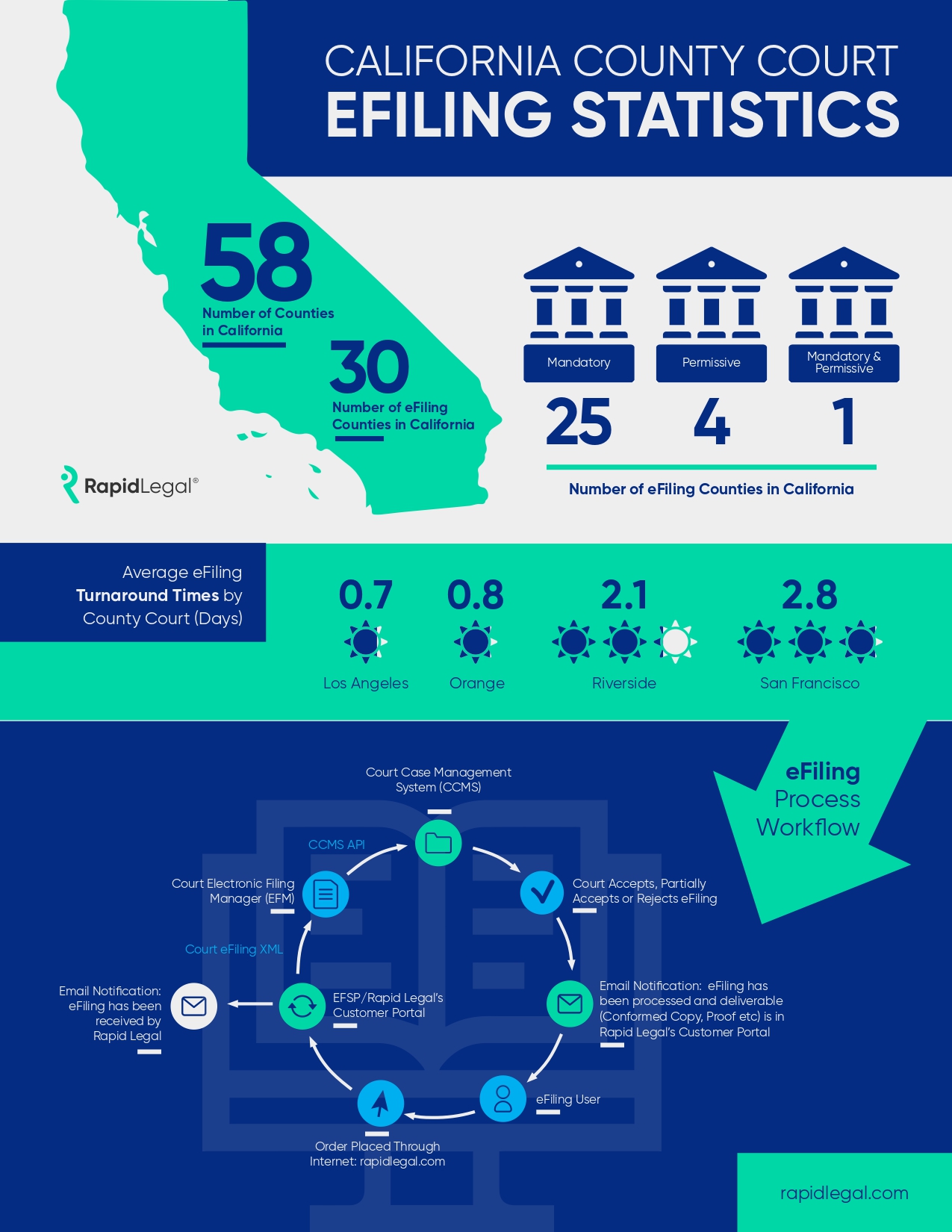5 Signs It’s Time to Switch Your Legal Support Service Provider
Law firms must operate at the top of their game in every way, but a poor performing litigation support service provider can create setbacks for firms that have costly consequences. Use this infographic to recognize whether your current litigation support service provider is an asset or liability.
Find out what kind of provider you have.
Download this PDF and learn at-a-glance how to read the signals from customer support, pricing, performance, and more. Some are subtle while others are more clear, but each indicates trouble ahead so it’s important to recognize them all.
You can also help your colleagues and friends who work in the legal industry avoid these problems. Share this infographic as a URL or attach it to an email as a PDF and spread the word.
Predictions for the Legal Industry in 2023

The tricky thing about seeing the future is seeing the future of things that actually matter. For the legal industry, technology has a direct effect on the speed, accuracy, and security of work, so we did our homework and focused predictions on four core technology areas that will matter to nearly every legal professional in 2023: integration, automation, data, and cybersecurity.
Rather than examine each of these areas from a high-level conceptual perch, we view them from the ground level to assess how they may change things for legal professionals as the year unfolds.
Here’s what we found and what you should prepare for—or take advantage of.

Move faster from Point A to Point B
Integrations almost always result in getting more done in fewer steps, which is why they appear at the front of this parade. One of the best efficiency payoffs we predict for 2023 will come from the integration some litigation support service providers have stitched together with document management systems (DMS).
That’s because these digital mergers accelerate the speed and accuracy of eFiling and other litigation support services that require the use of documents saved in a DMS.
In terms of law firm productivity, here’s a clear example of why these integrations matter:
Traditionally, if you wanted to use documents from a DMS with an eFiling, you’d be slowed down by a clunky transfer process that looks like this:
- Retrieve documents from the DMS.
- Download the documents to your local drive.
- Upload the documents to a litigation support service provider’s platform.
- Lather, rinse, repeat.
In contrast, the integration between the DMS and litigation support service provider makes the process leaner.
That’s because the integration allows you to access your DMS from the same browser window you’re already working in as you create an eFiling order.
This more efficient process is already saving time on eFiling and other litigation support service orders offered by Rapid Legal. The company engineered an integration with iManage and NetDocuments that shrinks the traditional way of wrangling assets from a DMS into this simple process:
- Select iManage or NetDocuments from the dropdown menu in the Rapid Legal portal, select the documents you need, and add them to your order.
That’s it. No extra steps.
You can watch this seamless process in action in this explainer video.
Another important integration the legal industry will welcome in 2023 comes from search engine behemoth, Google. Keep your eye on this one because it’s likely to help you reduce document rejections caused by inaccurate or incomplete address information.

Location, location, location!
Getting the right location is as crucial for legal documents as it is for buying real estate. To help make location-based information for litigation support service orders as accurate as possible, Rapid Legal engineered an integration with Address Validation by Google.
Here’s how it will affect your work:
As you type an address into a location-based order, Google recommends a match from its 160 million addresses. You select the address you want and Address Validation by Google validates the information for accuracy and completeness. This feature also:
- Adds missing information such as street designation or ZIP codes.
- Determines the type of address automatically (business or residence).
- Searches by business name only (Google adds the full address).
Take a look at Address Validation by Google in this explainer video and you’ll understand why we predict integrations will be headline news for the legal industry.

Automation: The bot will see you now
It’s official: Automation in the legal industry is no longer just for number crunchers. Automation has moved beyond the dry landscape of actuarial calculations onto a colorful new plane where it helps law firms become more, well, chatty.
Just ask the chatbots.
Chatbots are artificial intelligence (AI) tools that help offload work from human counterparts. This makes them seem like the inevitable MVP for many hyper-busy law firms.
If you’re asking, “What have chatbots done for me lately?” here are two important tasks they perform to help law firms manage workloads:
- Welcome visitors to the law firm website and provide immediate attention.
- Respond to online FAQs from prospects and clients.
But wait, there’s more.
Chatbots have mastered the digital meet-and-greet in multiple languages, perform their tasks 24/7 for no salary, and never call in sick. Chatbots also free up law firm staff to focus on higher value work, which is something office managers appreciate.
The growth arc for chatbots won’t flatten out any time soon. As popular as they will become, though, chatbots will be only part of the legal industry’s automation story for 2023. That’s because automation-based discovery tools have gotten a foothold among 21st century law firms, which positions them for higher levels of adoption.
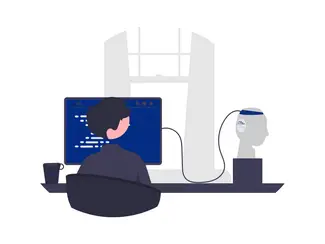
Automated convenience
The use of automation tools for early discovery will grow this year for good reason: The costs associated with the discovery phase of a trial may balloon up to more than the cost of the trial itself.
Artificial intelligence changes that calculus by assisting with the tedious, time-consuming portion of early discovery. That includes tasks associated with collecting, processing, searching, reviewing, and analyzing data. All handled in a fraction of the time manual methods require.
Another area where AI tools will grow in popularity is contract review. Similar to the reasons legal professionals use AI-based early discovery tools to save time, they will also use AI-based contract review tools to review and remediate contracts in far less time than manual methods.
Automation for litigation support services
Automation is catching on among litigation support service providers, and their expanding use of this technology in 2023 shows no sign of slowing down. The appeal of automation lies in the efficiency and peace of mind it offers busy legal professionals.
The popularity of automated services has risen quickly among Rapid Legal’s own customers, where the company applies automation to:
- Proof of Service alerts sent automatically to a customer’s email inbox to advise that service has been completed.
- Electronic payment systems that move payment for service online and eliminate paper checks. This automation makes paying for litigation support service orders paperless and nearly instantaneous.
The more you use these integrations the more you’ll wonder how you ever worked without them. If you are a manager, you’ll wonder how you ever managed without them.
And, there is more good news coming for firms that want to manage operations efficiently: Data they’re probably already sitting on can be used to strengthen the bottom line.

Know your data, know yourself
Do you know whether your firm is making money? Do you know whether your clients are happy?
Some law firms have no clue how to answer these questions, a phenomenon observed by Nicholas d’Adhemar, founder and CEO of Apperio, in an interview with Law.com.
d’Adhemar says the majority of large legal departments do not measure in-house activity. That lack of insight, he explains, leaves firms in the dark about key business metrics.
But that’s about to change.
“[Law firms will] increasingly look to legal technology to scale and streamline workflows and capture data to prove their value,” d’Adehmar says.
And, as law firms begin to use data about themselves and their clients, they increasingly will begin to measure efficiency, client satisfaction, and legal spend, d’Adhemar explains. Doing so will allow them to manage those areas more effectively.
d’Adhemar isn’t the only one who thinks so.
Scott Forman, Chief Data Officer, Littler Mendelson, says legal service providers and law departments have pulled insights from their own data ecosystems in the last few years to reap substantial returns.
They’ve been able to do this by investing in technology.
“For those with established data science teams and operations, now is the time to really leverage the work done to organize and aggregate their data to optimize internal processes and enhance the delivery of legal services,” Forman says.
Law firms are learning that data helps them effectively manage the most important areas of their business, which is to say they are learning the value of data.
Unfortunately, cybercriminals also know the value of data and have grown more ambitious in their attempts to steal it. Which raises an important question for law firm leadership to ask themselves in 2023: “What are we going to do about it?

A culture of security
The sheer volume of digital outlaws operating in cyberspace makes the online world seem like the Wild West. In 2023 alone cybercriminals are projected to cost the global community $8 trillion, and no one expects them to disappear anytime soon.
The fallout from cybercrime is so bad Warren Buffet characterized it as the #1 problem with mankind.
It’s not just Warren Buffett who’s troubled by cybercrime—it’s also troubling to 42% of law firm business leaders who rated security breaches, data loss, hacking, and ransomware as high risks to law firm profitability.
Is there a way to fight back?
Yes, there are a number of methods the legal industry can use to combat cybercrime. Among the most promising and practical are:
- Security tokens
Physical objects such as a smart card, USB key, mobile device, or radio frequency ID card that provides authentication by generating a password that allows you to access a system. - Security training awareness programs
Cybersecurity awareness training addresses everything from bad practices to cyber assessments, cyber incident responses, and more. The training helps workers at all levels across a law firm identify online security risks and avoid them. - Passwordless technology
Devices are unlocked using methods such as a fingerprint, face verification, or “magic link.” Magic links are similar to a one-time use code you’d receive via email, except the link enables you to log into a system directly by clicking on it. Apple passkeys are an example of passwordless technology, engineered to function across all Apple devices as well as non-Apple devices within physical proximity. - Multi-factor authorization
Multi-factor authorization requires two or more forms of evidence to access an account: for example, a password with a single-use PIN. Some variations may include a password combined with a biometric identifier such as a fingerprint, face, or retina.
Cyberattacks on the legal industry will almost certainly continue beyond 2023. However, a surge in the adoption of hacker-resistant technologies combined with education aimed at teaching legal professionals how to recognize and respond to cyberthreats could signal a lane change in how well the industry protects itself.

Grab your shades. The future looks bright
The legal industry has challenges to overcome in the year ahead, but even as the industry continues to emerge from the recent pandemic there is reason for optimism.
Perhaps the most compelling reason was captured in a recent survey in which an 84% majority of law firm managers or executives say they feel empowered to drive change from within their firms.
Rapid Legal is here to help law firms and legal professionals across the legal industry drive positive change and strengthen their position. Contact us to find out how our integrations, automations, and other data-driven services can help your law firm save money, operate more efficiently, and make 2023 one of your best years ever.
Schedule a demo or set up a call with a Rapid Legal account manager today!
Simple Meditations for the Busy Legal Professional
Juggling multiple tasks for multiple matters without losing your patience can seem like a fine art. That’s why it’s important for legal professionals to stay relaxed and centered at work. The meditations in this infographic help you do exactly that.
Download the PDF now and begin using this infographic as a guide for each exercise. Perform them any time and any place to stay calm and relaxed; even when the office around you isn’t.
Do you have friends or colleagues who need simple options for staying focused? Help them out by attaching this infographic PDF to an email and sharing the techniques.
Stepping Into Change

Do you know someone who doesn’t like surprises or being told what to do? Those attitudes are prevalent among people who resist change at work and are shaped by several factors. Fortunately, resistance to change can be overcome.
This article shares approaches on how to overcome resistance to change and build enthusiasm for embracing the unknown. It likewise shows you how to use those principles to navigate a vendor switch to make the process smoother and less intimidating. Read on to learn how these methods work.

Why we resist change
Change is a constant in the workplace. Overcoming resistance to change is no longer just a nice-to-have; it’s become mission-critical to the success of businesses and the people who work in them. The first step to conquering this resistance is to understand why some people resist change.
Researchers have compiled a laundry list of reasons people avoid change, such as:
- Disturbed practices, habits, and relationships
- Lack of respect and trust in the people who promote change
- Self-interest and shifts in power and influence
- Dislike of imposed change
- Dislike of surprises
- Reluctance of management to deal with difficult issues
- Lack of self-confidence and confidence in others
Experts wrestle with the best way to effect change, but generally agree on one point: Adopting change is the only way to thrive in a digitally-driven business world that evolves rapidly.

How to step into change
Moving people from their ‘comfort zone’ means moving from the familiar, secure, and controllable, to the unfamiliar, insecure, and uncontrollable.
Here are four mindset shifts to help anyone warm up to the idea of change.
- Embrace the opportunity: Ultimately, if you don’t focus on the change, you won’t be successful. Maintaining a positive outlook and focusing on the change that is ahead will keep you from falling backwards.
- Be curious: Ask yourself, “How is this moment happening for me rather than to me.” Ask good questions and follow your curiosity. This will give you confidence to navigate what lies ahead.
- Accelerate your goals: Resisting change will slow you down from reaching your destination. Change presets you with the opportunity to go further, faster.
- Lean on others: You’re in this together. Recognize that you are not the only one experiencing the change personally or professionally. Reaching out to those around you can make it easier to navigate change.

Manage the fear factor
Anxiety. Fear of uncertainty. Fear of failure. All of these keep us from stepping into change, but—good news—each of these factors can be modulated.
Motivational speaker Tony Robbins offers an excellent set of techniques for overcoming fear. We’ve summed several that can be used:
- Adopt a growth mindset
It’s not about achieving your goals and being perfect every step of the way. It’s about getting comfortable with what you don’t know and continuing anyway. As Robbins says, “No matter how many mistakes you make or how slow your progress, you’re still way ahead of everyone who isn’t trying.” - Recognize excuses
Fear makes you procrastinate. It’s much easier to make excuses than put in the long hours and energy needed to reach your goal. Recognize when you are using excuses and figure out how to overcome them. Replacing them with a positive approach is a good start. - Know that failure is part of the process
Everyone on the planet – including those you know and admire – has encountered failure. Realize that your fear of failure is preventing you from making the decision to achieve your objectives. - Visualize your goals
Goal visualization sets your focus. This visualization may take the form of priming, meditation, or imagery training. What’s important is to see yourself succeeding and condition yourself into believing that you can do whatever you imagine. - Keep company with success
People who are focused on overcoming fear and achieving their dreams surround themselves with others who share that mindset. This group may include people you admire as well as those who will push you in a positive direction.
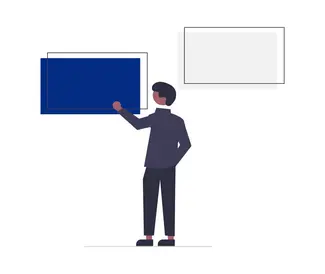
Change and the art of switching vendors
Don’t go through change alone. Find a strategic partner.
Changing litigation support service providers can help law firm staff members solve work-related frustrations and operate more efficiently today. But what about the future? With workflow automation, data, and digital transformation trends taking hold in the legal industry, not all vendors are prepared to support modern law firms seeking assistance in these areas.
You can sidestep that problem if you know how to evaluate whether your vendor has the stuff to be a strategic partner.
“Strategic” means the firm and the vendor can do more together than individually. A strategic partner has deep industry knowledge to know what else can be done with synergies created by systems and technologies beyond an obvious product feature.
How do I evaluate a vendor?
If you are considering switching vendors, don’t be sold on technology alone. The truth is technology by itself does not make a 21st century law firm.
The vendor you want should bring strategy and new ways of thinking to the table, as well as best-in-class technology.
An example of that may be found in how a vendor thinks about integrations or data metrics with the law firm.
If a vendor gives a law firm visibility and transparency into the litigation support service work itself, and shows the firm what more can be done to gain efficiency and cost savings on the execution of work the vendor does, that means the relationship is strategic.
A strategic partner will help uncover and examine a firm’s vision, strategies, and plans.
Firms that have the most data and insights will win
In the 21st century, change for the better means switching to a tech solution that produces data. That data should tell you how well your business is running. Furthermore, the data must be sharable and timely so you can use it to track performance and identify trends.
The ability to help you use data smartly is the mark of a strategic partner.

What kind of data can I use?
If you’re considering a switch, a new vendor should provide data associated with common litigation support services such as court filing, eFiling, and process serving. This data can help gauge the performance of vendors and function as a cost control measure.
Yes, it works
As an example, a firm can examine service of process orders by pricing zone to predict whether the cost of service of process in certain locales may be untenable. The firm may also use the reports to gauge a law firm’s internal performance and whether the vendor is delivering service as promised.
Other firms are using vendors that have this capability which means it’s no longer a nice-to-have but rather, mission critical.
Set expectations
A big part of what a firm can achieve depends on the providers they select to help them get the job done. But what is the job, exactly, and how should it be done?
Good leaders answer these questions by setting expectations for their firms and their vendors. They make sure those expectations are clearly defined by answering the following:
- What are the expectations?
- Can the vendor meet them?
- Have the expectations been clearly articulated?

The relationship you need and want
Some relationships continue long after their expiration date. That may be the case oftentimes between law firms and vendors. The law firm continues to do business with a poor-performing vendor simply because they believe changing vendors will require too much fuss and bother.
But that thinking is a good way to ensure you never get what you deserve or need.
If the aim of your vendor switch is to create a truly positive effect on your law firm, take a moment to think about whether your current litigation support service vendor offers:
- Transparency
- A dedicated account manager
- Data reporting that identifies good/poor performance
- Tying more strategic implementations into other systems
- Metrics that confirm cost savings
Even a good relationship should not stand in the way of a switch to something that helps the law firm operate at a higher level.
Make sure your partner is consultative. Find one that has deep industry knowledge it will share to reveal to you what else can be done to bring efficiencies, cost savings, and risk mitigation.

Change is good
Embracing change is a critical skill for your personal and professional life. Throw out the idea that change is hard and get your transformation moving with a change in mindset. Then, tap into your curiosity, peer network, and technology vendors to help reinvent yourself.
Remember, stepping into change will not only expand your knowledge and inspire your co-workers, but it will also make you stand out as a law firm and create competitive advantage.
Schedule a call or book a demo today with a Rapid Legal account executive today to find out how we can be a strategic partner and help you navigate change successfully.
Should You Be a Contract Paralegal?

You’ve heard the buzz. “Become a contract paralegal and work for yourself.” The internet is practically daring you to use its technology so you can decide when to work, where to work, and for whom to work.
Sounds good, right?
And it is good for many paralegals but becoming a successful contract paralegal requires more than just a laptop and broadband connection. If the idea of becoming a contract paralegal appeals to you, this article can help you figure out whether you’ve got the skills and aptitude for it, and provide valuable tips to help get you started.
What is a contract paralegal?
Let’s clarify the difference between a contract paralegal and a similar sounding but distinctly different role: independent paralegal. Here’s what defines each:
Contract Paralegal An individual who performs substantive legal work for law firms or corporations, or other entities but is self-employed. (Also known as a freelance paralegal.) | Independent Paralegal A non-attorney who provides legal document preparation services to the public and may be referred to as a legal document preparer or forms practitioner. Source: Paralegal Alliance |
As the definitions above note, the contract paralegal contracts with law firms. Their work is reviewed by the contracting attorney, who is likewise responsible for whatever work the contract paralegal has done.
An independent paralegal does not work under the supervision of an attorney.

Why become a contract paralegal?
Some opt for contract work because they want control over whether they work full-time, part-time, or just enough hours for the work to be a side hustle. For others, controlling whether they can work a flexible schedule in a home office is what draws them to this role.
Still others may like the idea of becoming a contract paralegal because they feel fed up with the stress of the law firm grind and want to protect their personal wellness. Doing contract work can also give them an opportunity to walk away from traditional employment and explore other areas of specialization, or routinely change work environments.
While becoming a contract paralegal can open the door to a more worker-friendly setting, perhaps the greatest benefit is that it offers those with an entrepreneurial bent a platform for becoming their own boss and a business owner.

(Almost) everyone is doing it.
Many experienced legal professionals have—at some point—felt tempted to leave the conventional workforce and strike out on their own. In fact, according to a recent survey, nearly one-third of employees polled indicated they left their jobs specifically to start a business.
Online technology makes it easier than ever for talented paralegals to do this because it equips them with resources only the deep pockets of established companies could once afford, such as:
- Free professional websites from providers such as WordPress and Wix.
- Free marketing on LinkedIn, Facebook, and other platforms.
- Fast paperless payment via online payment platforms that handle business payables and receivables digitally.
- Billable work that can be performed online through a litigation support service provider’s portal including, eFiling, service of process, document retrieval, and more. The portal allows paralegals to access the tools and data they need to perform these tasks from anywhere Internet access is available.

You’re a good deal for law firms
It’s fair to say that in some cases contract paralegals may help a law firm run leaner. The firm simply pays the contract paralegal an agreed upon wage and doesn’t have to bother with the additional cost of a benefits package, payroll taxes, or equipment and workspace.
In contrast, the expense of recruiting and onboarding a traditional hire can amount to a costly game of roulette, averaging about $4,700 in 2022.
That’s $4,700 paid for each new hire, regardless of whether the employee flops after two days or stays until retirement.
The expense of employer-paid taxes and employee benefits also inflates the cost of hiring a traditional, office-based paralegal. Those “hidden” payroll expenses can increase the all-in price tag to 1.25 to 1.4 times the employee’s salary.
Through the eyes of a law firm’s CFO here’s how that looks:
Hiring a paralegal as a full-time employee at an annual salary of $70,000
will actually cost a firm a benefitted salary of $87,500 to $98,000.

Speaking of money
California has more paralegal jobs than any other state. The salary range can vary widely depending on factors that include practice specialty, firm size, and professional experience.
According to Indeed.com, the average hourly wage for a contract paralegal in California is $34.15 per hour. Narrowing the focus to specific metropolitan areas, we see the average hourly wage in San Francisco is $38.50; in Los Angeles $34.56; in San Diego $33.75; and in San Bernardino $31.64.
Those figures offer an incomplete picture of actual earnings for contract paralegals working in the state, however, and don’t account for what experienced, highly-skilled paralegals can earn.
For example, one veteran California paralegal reportedly began her contract with a firm charging $75.00 per hour for probate work. That figure soon rose to $115.00 per hour.
The key to finding such lofty earnings, it seems, is to find a niche where you’ll be paid for your subject matter expertise.
Test yourself
By now you may be feeling pretty good about becoming a contract paralegal. However, before you turn in your resignation and hang your shingle, make sure you can check the following boxes.
▢ Can you live without employer-sponsored benefits?
Some of the most affordable non-employer sponsored insurance programs are HMOs or programs with only a limited number of physicians that may not include your primary care provider.
▢ Are you entrepreneurial?
Unless a throng of law firms is already knocking at your door, you’ll most likely need to market yourself to pull in leads and close business. Most successful entrepreneurs are also competent networkers, so if you’re a wallflower or an introvert consider whether those traits may hold you back.
▢ Are you a good administrator?
You’ll have to pay self-employment taxes and track expenses, so good follow-up and follow-through is a must. You can outsource these tasks to a bookkeeper or accountant but doing so will cut into your earnings.
▢ Can you prove your value to an attorney?
You may think you’re being productive, but you’ll need to prove it. Finding that proof may mean you have to examine invoice data and crunch the numbers to determine how your presence has increased the firm’s billing.
▢ Can you build rapport with the law firm staff?
A full spectrum of personalities inhabits the legal profession. A successful contract paralegal must be prepared to work with them all – at the office and from home.
▢ Are you up to speed with the technologies law firms use?
Regardless of whether it’s trial presentation software or office management software, your skills must be sharp, and you must understand the practice’s preferred tech stack. Remember, part of the contract paralegal’s appeal is that they should require minimal training.
▢ Who’s on your litigation support service provider shortlist?
Be sure you have a vendor that can provide customer and court references. Your preferred vendor should also provide eFiling in every California court that offers eFiling in addition to the electronic and physical services you need most from a single customer portal. You’ll also need to know how to interview a vendor for eFiling and service of process.

Find your gig
Once you make the transition to contract work, you’ll want to fill your client book quickly. Niche practice areas can help you do that because they offer some of the best opportunities for skilled contract paralegals. Here are several areas to target:
Litigation: A successful contract paralegal in the litigation setting may be one who can write specific types of pleadings or who excels at drafting motions.
Estate planning: Many estate planning attorneys prefer to outsource probates to contract paralegals because they are time-consuming. And, oftentimes, the attorney’s staff does not have the training to complete probates properly. Therefore, contract paralegals who are particularly good at probate-related work may find opportunities in this specialty.
Small firms or solo practitioners: Smaller law offices simply may not have the resources to hire a full-time paralegal. But, by having you handle overflow or administrative tasks, you free up the attorney’s time to devote to billable hours.
Real Property Law: You’re unlikely to become bored in real property law. This type of practice requires many different tasks associated with due diligence and often demands interaction with multiple parties. It is fast-paced and can demand long hours as well as weekend work to close transactions on schedule.
Weekends and evenings: Being able to work outside of regular office hours may give you a leg up as a contract paralegal. This type of schedule flexibility may make you attractive especially to law firms that work on deadline-driven projects such as mergers and acquisitions, real property law, and government projects.

Get your wings
Still wondering whether becoming a contract paralegal is the right move? There’s only one way to know whether the idea will fly.
But, before you cut the cord as a fully employed paralegal, assess your suitability carefully. If you have lingering questions or difficulty finding answers, approach your peers at association meetings or look to professional organizations that serve paralegals.
California has the largest court system in the country, which means that if you’re determined to find your own success as a contract paralegal, you’ve come to the right place.
Rapid Legal Delivers a More Streamlined eFiling Experience by Integrating to Leading DMS Platforms

FOR IMMEDIATE RELEASE
Rapid Legal Delivers a More Streamlined eFiling Experience for Law Firms by Integrating to Leading Document Management Platforms
CHINO HILLS, CA – December 5, 2022 – Rapid Legal Inc., a premium legal services and technology company, today revealed new integrations with the NetDocuments and iManage platforms and a partnership with ECFX for the automatic processing of electronic court filing notices.
NetDocuments, the trusted cloud document management platform for legal professionals, enables law firms and legal teams to secure, organize, automate, and collaborate on documents throughout their organization. With state-of-the-art security coupled with innovation and hundreds of integrations, NetDocuments supports 7,000+ law firms, legal teams, and public sector entities worldwide.
iManage, a cloud-enabled document management and collaboration platform underpinned by best of breed security, sophisticated workflows, and governance approaches, boasts over one million professionals at over 3,500 organizations in over 65 countries – including more than 2,500 law firms and 1,200 corporate legal departments and other enterprise customers.
ECFX, an enterprise notice management system, processes all Federal and State notices automatically for law firms and corporate legal departments. Built to work with a firm’s existing ecosystem, integrating with the firm’s case management, document management system (DMS), and time and billing software, ECFX automates the processing of electronic court filing (ECF) notices-saving a firm hundreds of hours a week to focus on client work and business outcomes.
Rapid Legal’s integration with these platforms marks another step forward for Rapid Legal in fulfilling its vision of “connecting the entire legal community for seamless document exchange” and its purpose of “automating the processing of legal documents.”
“The legal services market is transforming, from courts and law firms to the parties they serve. This transformation has only accelerated during the pandemic years with new firm models, including a hybrid work model, taking hold. Workflow and document automation has become a key consideration in this ongoing transformation. So, offering the ability for our law firm customers to access documents from the systems they know, and love is critical,” said David Nill, CEO and Founder of Rapid Legal.
The integrations with NetDocuments and iManage will allow legal professionals to seamlessly upload and download documents for their eFiling orders from the document management systems. The time saved from these integrations not only produces a demonstrable ROI for the law firm, but also frees firm resources to address higher value work. Moreover, the partnership with ECFX offers additional automation features law firms can use to enhance how their document management systems interact with Rapid Legal’s platform for maximum efficiency and productivity.
About Rapid Legal
Rapid Legal is a premium legal technology company that automates the processing of legal documents for law firms. Headquartered in Chino Hills, California, the company is a leading certified eFiling Service Provider to courts in 36 California counties, with more on the way. Combining deep industry expertise, superior performance, and innovative technology, Rapid Legal is transforming the way the legal community exchanges electronic documents, information, and payments, to streamline how law firms manage work, and for the effective and expeditious administration of justice.
To learn more, please visit https://rapidlegal.com.
5 Secrets to Successful eFiling
Every legal professional wants to level up their eFiling success. This infographic gives you a visual shortcut for learning five key practices designed to help improve your eFiling accuracy, efficiency, and court acceptance rate.
These helpful takeaways are visually oriented, quick to absorb, and very easy to share.
Speaking of sharing…
It couldn’t be easier to pass this infographic to a colleague or friend. Just click on the download button below for a full-size PDF you can share as an email attachment or print to a desktop printer.
Want to learn more ways to improve your eFiling success?
Check out these guides and eBooks that Rapid Legal created especially for legal professionals. You’ll get everything from eFiling 101 basics to pro tips from our operations team. Click on the links below and begin your transformation into an eFiling power user.
The Complete Beginner’s Guide to eFiling in 2022 and Beyond
5 Secrets to Successful eFiling
A Complete Checklist for Selecting a Certified eFiling Service Provider
The eFiling and Legal Tech Dictionary for Legal Professionals
Note: All information in this infographic is current as of Oct. 1, 2022.
The Complete Guide to Physical Filing in California Courts

Table of Contents
- Physical filing in California Superior Courts
- Three ways to file physically in California courts
- #1: In-person physical filing
- #2: Physical court filing by mail
- #3: Physical filing by fax
- Common mistakes with physical court filings
- Improve your court acceptance rate: Let Rapid Legal physically file for you

Physical filing in California Superior Courts
It’s a fact: The Golden State’s Judicial Court system is the biggest in the nation and one of the busiest in the world.
And about 26% of the 636,142 court filings in California in 2021-2022 were physical filings, so there’s a good chance that sooner or later you’ll need to do a physical filing for your firm.
Despite electronic filing making strong inroads throughout the California judicial system, physical filing is still used in 28 of 58 county superior courts as of Q3 2022. In the table below, each county that allows physical filing in one form or another is linked to the respective court’s website.
Table 1.
| California Superior Courts Using Physical Filing Methods | ||
|---|---|---|
| Alpine | Madera | San Joaquin |
| Amador | Marin | Shasta |
| Colusa | Mariposa | Sierra |
| Del Norte | Modoc | Siskiyou |
| El Dorado | Mono | Solano |
| Glenn | Nevada County | Trinity |
| Humboldt | Plumas | Tuolumne |
| Inyo | Sacramento | Ventura |
| Lake | San Benito | |
| Lassen | San Bernardino | |

Three ways to file physically in California courts
The numbers make it clear that physical court filing is going to be with us for some time, even though it is a slower process than filing electronically. To keep your physical court filings from slowing down even more, it’s important they get done right the first time.
This section of the guide helps you do that, beginning by breaking down the three ways court documents may be physically filed in California:
- In-person (at the filing counter of the court’s clerk or at a drop box).
- By mail.
- By fax.
The requirements for physical filings can vary from court to court and depending on the type of matter or proceeding. Filers need to understand each court’s particular filing criteria.
So, before you enter the first keystroke for your filing, make sure you know:
- Type of physical filing permitted by the court.
- Forms required.
- How to correctly fill out a form.
- Filing deadlines.
- Formatting, binding and information requirements of the document and exhibits.
- Number of copies needed.
- Filing fees and how to pay them.
- Return document requirements.

#1. In-person physical filing
At the counter of the court clerk
The court clerk window (or counter) is the hub of physical filing. In person, this is where documents are submitted, and the filing fee is paid.
Two important things happen at the court clerk’s window during physical filing:
- The court clerk inspects the document to ensure it complies with the court’s rules and verifies the information is correct.
- If the information is correct the clerk stamps the document and the copies as received. For the filer’s records and evidence that a filing took place on the said date, the court clerk should then provide what is called a ‘conformed copy’ which is an exact copy of a document filed with a clerk with an official stamp.
Knowing immediately that a document has been accepted by the court provides the filer peace of mind, especially when a tight statutory deadline must be met.
The tradeoff, however, is that peace of mind most likely will be earned by someone spending long periods of time waiting in line.
Something cool about physical filing The physical court document filing process is slower and more cumbersome than filing electronically (eFiling); that’s not news. But what is newsworthy is this one distinct benefit that in-person court filing offers: The filer knows immediately whether the document was accepted or rejected by the court clerk. This benefit doesn’t get a lot of applause, but courts’ online technologies haven’t been able to beat it yet. |

At a court drop-box
It’s not uncommon for courthouses to experience reduced hours or for staff to be furloughed due to judicial budget cuts.
Therefore, drop boxes can be offered by courts to make physical filing still available. Drop boxes allow documents to be deposited for filing outside of a court’s normal operating hours or at other times of the day when a court is not accepting counter filings.
California Rule 2.210 states how drop boxes are to be used when it is an option:
(a) Use of drop box
Whenever a clerk’s office filing counter is closed at any time between 8:30 a.m. and 4:00 p.m. on a court day, the court must provide a drop box for depositing documents to be filed with the clerk. A court may provide a drop box during other times.
(b) Documents deemed filed on day of deposit
Any document deposited in a court’s drop box up to and including 4:00 p.m. on a court day is deemed to have been deposited for filing on that day. A court may provide for same-day filing of a document deposited in its drop box after 4:00 p.m. on a court day. If so, the court must give notice of the deadline for same-day filing of a document deposited in its drop box.
(c) Documents deemed filed on next court day
Any document deposited in a court’s drop box is deemed to have been deposited for filing on the next court day if:
(1) It is deposited on a court day after 4:00 p.m. or after the deadline for same-day filing if a court provides for a later time; or
(2) It is deposited on a judicial holiday.
(Subd (c) amended effective January 1, 2007.)
(d) Date and time documents deposited
A court must have a means of determining whether a document was deposited in the drop box by 4:00 p.m., or after the deadline for same day filing if a court provides for a later time, on a court day.
Rule 2.210 amended and renumbered effective January 1, 2007; adopted as rule 201.6 effective January 1, 2005

Drop box requirements will be different. Count on it.
California courts are characterized by a patchwork of court requirements that vary from one jurisdiction to the next. What you know about one California court may not apply to courts across the county line, including requirements for drop box filings.
Therefore, filers should be sure to know the differences about the following before they use a drop box:
- Date stamping procedures
- The kinds of documents can/cannot be filed via drop box
- Use of pouches or folders for depositing documents
- Inclusion of filing information in the pouch or folder
- Enclosing correct filing fee
- Providing return envelopes for conformed copies for pick up by a messenger
- Enclosing self-addressed, stamped envelope for copies to be returned to the filer by mail.
Are they safe?
Drop boxes have been around for a long time. For example, the U.S. Postal Service’s proto drop box (known as a letter box) first appeared in 1858. The kangaroo, nature’s original drop box, appeared even earlier.
The low-tech nature of the drop box may lead you to question whether it is secure and safe to use.
The answer is, “Yes.”
Drop boxes are considered a safe method for physical filings and documents are usually processed the next day.
Note: Some California courts are experiencing delays with drop box filings and have long turnaround times for certain kinds of filings.
For example, if you are currently filing into San Bernardino County Court or Sacramento County Court, Table 2 notes the delays in turnaround times you may anticipate for drop box filings:
Table 2.
| San Bernadino County Drop Box | |
|---|---|
| Type of Filing | Turnaround time |
| Case Initiation | 5 Weeks Behind |
| Answer | 2 Weeks Behind |
| Sacramento County Drop Box | |
|---|---|
| Type of Filing | Turnaround time |
| Case Initiation | 4-6 Weeks Behind |
| Other Documents | Time Varies |
Also noteworthy: San Bernardino County Court and Sacramento County Court require mandatory drop box filings for civil filings, and only Sacramento Family Court currently allows counter filings. However, there may be up to a 3-hour wait in line to do a counter filing in Sacramento Family Court.

#2: Physical court filing by mail
In most cases, documents can be filed by mail in any court that accepts physical document filings. It is important to keep in mind that filing by mail may slow down the process and should be avoided if your filing has tight deadlines.
Filing by mail is not as immediate or safe as filing in person at a counter/window, where you know if your filing is accepted and have your documents stamped on site.
Moreover, filing by mail adds the risk of your package becoming lost or delayed in the mail.
To find out what a court requires to file papers by mail, call the court clerk and ask about:
- The number of copies that need to be included with your original documents.
- The amount of the filing fee and the payment methods the court accepts.
- The court’s mailing address.
- How to provide for the return of your filed documents (i.e., If you need to include a self-addressed envelope with enough postage so the clerk can return the filed documents back to you).
Need Physical Court Filing AND eFiling?
Rapid Legal’s technology and document specialists can help you with all your civil court filings in California.
Contact an account executive now: (909) 664-9565
#3: Physical filing by fax
The fax lives on in the California court system. Some California courts allow filing by faxing documents to the court and provide a dedicated fax number. As with other kinds of physical court filings, there are different requirements and considerations for fax filings. These include:
- The use of fax cover sheet.
- Marking documents “By Fax”.
- Restrictions on the number of pages.
- Filing fees (which include court filing fee, an additional fee per page and a fax filing fee).
- Inclusion of instructions for payment.
- How receipt of the documents will be confirmed by the court.
It is important to confirm that a court accepts fax filing and to contact the clerk of the court, if needed, to understand the requirements and obtain the correct fax number.
Common mistakes with physical filings
Even some of the most experienced legal professionals can make missteps with physical filings. Some of the most common errors are:
- Missing pages
- Missing required local court documents
- Incorrect case number
- Missing signature
- Document not legible
- Court location is different on documents than where the filer is trying to file
If you’re wondering how to stay on top of it all, the following resources can help bring you up to date about specific state and county rules:

Improve your court filing acceptance rate: Let Rapid Legal physically file for you
Don’t have time to manage and track your physical court filings? Rapid Legal can take care of it for you in one of two ways.
Log on to Rapid Legal portal, upload your documents and place the order yourself. Rapid Legal will then arrange to have your documents filed at the court and provide you with confirmation and court-stamped documents. | Use our Concierge Service and Rapid Legal will handle your physical court filing from start to finish. Our experts review your documents to check that they are correctly formatted and assembled and details such as signatures, parties, case numbers, etc., are included in the documents as needed. Rapid Legal arranges to have your documents filed at the court and provides you with confirmation and court-stamped documents. |
Rapid Legal can file physically into all California Courts that require physical filing.
Our technology makes your physical filing fast and easy, and the deep experience our court filing experts have with the California courts means they understand the variations in physical filing requirements across the state.
Turn to an experienced provider who understands the local court rules, can make your filings more efficient, and free up valuable firm resources.

Ready to find out more?
Book a demo or schedule a call with a team member. Get a close-up view of the Rapid Legal portal and how we can help with your physical filing needs and more.
California County Court eFiling Statistics and eFiling Workflow
Times are changing in the California Courts and electronic court document filing (eFiling) is helping drive those changes.
If you’ve been wondering how the trend may affect you, review this infographic to get a look at how eFiling turnaround times are performing and to understand the eFiling process workflow.
Share this infographic
Do you have a colleague or friend who could benefit from this information? This infographic is easy to share. Click the download button below for a full-size 8.5” x 11” PDF you can print to a desktop printer or share as an email attachment.
Want to know eFiling A to Z?
Rapid Legal offers guides and eBooks that explain the nuts-and-bolts of eFiling and how to get the most from an eFiling provider. Build your eFiling expertise with this free, informative content written for legal professionals who work hands-on with court document filings:
The Complete Beginner’s Guide to eFiling in 2022 and Beyond
5 Secrets to Successful eFiling
A Complete Checklist for Selecting a Certified eFiling Service Provider
It’s Time for Law Firms to Think Differently About How They Use Litigation Support Service Providers
The eFiling and Legal Tech Dictionary for Legal Professionals
Note: All information in this infographic is current as of Sept. 1, 2022.
Myths and Facts about Process Servers

Not everyone has the right stuff to be a process server. It is a vocation that requires the tact of a diplomat, the instincts of a bloodhound, and the patience of Job. It can be a difficult profession to describe but one that deserves clarity. Why? Because a process server who does the job badly can compromise an entire legal matter.
This article erases 6 common myths about process servers. It replaces misperceptions with a clear view of the resourcefulness, technical savvy, and almost encyclopedic knowledge about serving legal papers that good process servers must possess.
Getting the facts will also help you make sure the providers you hire and work with will are able to do the job right.
Myth 1: A Process Server’s Job Involves Disguises, Danger, and Deception
Fact: There are indeed times when a process server must handle a reluctant person or an emotionally charged situation. More commonly, though, the individuals being served accept service without incident and treat a process server as someone who simply is doing his or her job.
Good process servers know they cannot break the law while serving documents. By obeying the laws process servers make their own jobs safer, which means they do not under any circumstances:
- trespass on private property
- break into a home
- pretend to be a police officer or an officer of the court
- force doors open
- look in or open mailboxes
- deliver documents to a minor
- make threats.
The best process servers understand the minutiae of the local rules that prescribe how documents must be served, who can be served, how service should be completed, and related deadlines. Process servers must continually update what they know and stay abreast of rule changes.
Do you think you know a good service of process provider when you see one?
Test your knowledge here:
What to Look for When Hiring a Process Serving Company.
Myth 2: Process Servers Must Physically Hand-deliver Papers to a Person Being Served
Fact: Despite popular belief, a process server does not need to physically put the legal papers into the hands of the person they are serving. And, contrary to popular portrayals on television or film, they don’t have to say, “You’ve been served!”
While rules vary from state to state, documents are generally considered served when the process server has confirmed the identity of the person being served. At that point, the documents may be handed to the person or left at the door or a nearby place if the person refuses to accept them.
Each state, county, and local municipality has regulations and guidelines regarding how and when different paperwork should be delivered. A truly exceptional process server will be able to tell you what they are without losing a beat.
Ask these nine questions to get the clear and direct answers you need to qualify a process serving company.
9 Questions to Ask a Process Serving Company
Myth 3: Almost Anyone Can Be a Process Server
Fact: While most states require no special licensing or education to be a process server, the skills, and qualities needed to be effective at process serving extend far beyond those for simply delivering documents.
Good process servers are valued for their efficiency, efficacy, and reliability. But a more specific set of qualities separates excellent process servers from the merely adequate. They include:
- Resourcefulness
- Patience
- Industriousness
- Craftiness
In California, process servers are required to apply and be registered in the county where they serve. Registration is statewide and the process server must have lived in California for at least 1 year.
Myth 4: Process Servers Only Serve Legal Documents
Fact: The work of a process server isn’t limited to simply handing over documents to the receiving party. A professional server applies specific skills, knowledge, and tools to successfully complete the full scope of tasks associated with service of process.
Knowledge
Getting an individual served and having the service stand up in court requires knowledge of the court rules and service requirements, so process servers must stay abreast of state regulations, research methods, and technology. They must be well-versed in the substance of subpoenas, summons, complaints, and other legal documents.
Research
Process servers oftentimes are tasked with finding hard-to-locate individuals, which requires using both online and offline resources to home in on the location of persons or businesses.
- Because people are more mobile than in the past, it can be challenging to locate a current address for someone.
- Businesses that operate as a “dba” or through shell companies can also be hard to locate.
- Considerable research may be required to find a current address before having to petition a court for substituted service.
Process servers use a range of technology to conduct research to locate a person or entity including:
- Search engines
- Social media sites
- Databases
GPS-enabled mobile apps that verify location are also essential tools for process servers who need to record delivery attempts.
Use of Technology
Arguably one of the most advanced uses of technology by modern process serving companies (and other attorney service providers) is a high-performance technology platform for managing their services and workflows.
A technology platform provides a process serving company an online portal for ordering, tracking, and completing service of process. A portal allows a process server to submit, manage, track, and execute each order for service of process anywhere in the nation from a single point.
The technology platform a process server uses should also improve efficiency in two important ways:
- Eliminate paper controls.
- Save time by enabling the process server to eSign the proof of service.
Process servers with this portal/technology can typically provide clients superior service because they can better utilize their internal expertise, reduce errors, provide more timely updates to clients, and better prioritize each order.
If your process server isn’t using the right tools they can’t deliver the best results.
Read: Technology Your Process Server Should Be Using to find out if you’re getting all the speed and conveniences available.
Myth 5: A Process Server’s Job is Complete Once the Papers Have Been Served
Fact: After serving court documents, one crucial step remains to complete the service of process: the process server must submit Proof of Service to the court.
Sometimes called an Affidavit or Certificate of Service, Proof of Service is a document that functions like a sworn statement from the process server confirming the delivery of documents from one party to another in a legal matter.
Proof of service also provides a valuable protection to a court case: If a defendant wrongly claims papers were never served, proof of service demonstrates otherwise.
It may seem like a minor formality, but proof of service performed incorrectly can profoundly impact a legal matter by creating delays or causing a case to be dismissed.
Common errors include:
- Not using the correct form for proof of service based on the type of legal document that was served
- Filling out a form inaccurately or incompletely
- Missing the deadline for filing the original completed Proof of Service
- Not following the correct process for filing Proof of Service when substitute service was used instead of personal service.
Using a qualified service of process provider will help you know as quickly as possible whether service has been effected and properly completed. Rapid Legal, for example, generally returns the proof of service within 2-3 business days from the date service takes place.
Legal professionals who use Rapid Legal’s service of process receive an alert directly in their email inbox notifying them that service has been completed. This means they spend less time following up with vendors and worrying about their order status.
Want to Build Your Proof of Service Knowledge?
Use this Resource:
Proof of Service Boot Camp: What Every Legal Professional Should Know
Myth 6: Avoid a Lawsuit by Avoiding a Process Server
Fact: Lawsuits cannot begin until a defendant has been properly served. For this reason some people mistakenly believe they may avoid a lawsuit simply by avoiding service.
Avoiding a process server may delay a lawsuit but it does not mean legal documents cannot be served and the process cannot continue. The courts realize some individuals will avoid service and consequently have established provisions for evasive, hard-to-serve people.
The rules vary among jurisdictions but many courts require process servers to make at least three attempts to serve someone in person.
Furthermore, some courts may require personal service to be attempted at certain times of day to maximize the likelihood of a successful serve.
If personal service on an evasive party cannot be completed after multiple attempts, a process server may perform substituted service of process on another person or entity.
Substituted service can include:
- Leaving the papers with an agent of the recipient;
- Leaving them with an adult of sound mind at the recipient’s home;
- Leaving them at the corporation’s office—or place of transacting business; or
- Posting the papers in a public place and then mailing copies of the documents to the recipient(s).
The types of parties that may be used for substituted service vary, so a process server must be well acquainted with the local court rules governing substitution of service.
The Right Process Server for the Job
Process servers are the arms and legs of civil litigation. Millions of dollars in fees and settlements hinge on good process serving so it is critical to have a quality process service provider with the experience, know-how, and technology platform to get the job done.
Put Rapid Legal’s best-in-class service of process to work for you. Make your move to begin receiving court-stamped documents and proofs of service fast and reliably.
Book a demo or schedule a call with an account manager now.


